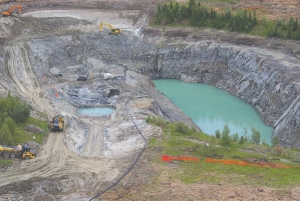Nearly two months after Xstrata (XTA-L, XSRAF-O) announced it would start building the Bracemac-McLeod deposit into a zinc mine near Matagami, Que., with jointventure partner Donner Metals (DON-V), the companies have released a positive feasibility study for the deposit as well as an inferred resource for an area of it called the McLeod Deep zone.
Xstrata wants to have the Bracemac-McLeod underground mine operating in time to replace its Perseverance zinc mine, which is slated to close in 2012. The decision to build the mine, announced on July 9, was made quickly to try to avoid a gap in mill feed at Xstrata’s refurbished 2,600-tonne-per-day Matagami mill complex, about 4 km from the planned mine.
“Xstrata didn’t want any lag time and they wanted to start construction in July,” explains Andrea Magee, Donner Metals’ head of investor relations. “They skipped the prefeasibility study stage completely based on what they found in the scoping study.”
Mining and development will be in two phases with a total of 30 km of ramping and preproduction development. The first step involves building a 2.3-km ramp from the previously producing Bell Allard open pit to the Bracemac zones and 11.4 km of preproduction development followed by production starting in late 2012 or early 2013. (The Bell Allard open pit operated from 1968 to 1970 and produced 230,000 tonnes of 9.24% zinc and 1.14% copper at a depth of 18 to 70 metres.)
The second phase will start with production at Bracemac and will involve building dual ramps from Bracemac to McLeod totaling 3.6 km and 12.7 km of preproduction development that should be wrapped up by late 2013.
Mine planning was based on reserves of 3.73 million tonnes grading 9.60% zinc, 1.26% copper, 28.25 grams silver per tonne and 0.43 gram gold per tonne and incorporated an average 19% dilution. Measured and indicated resources tally 3.39 million tonnes of 11.31% zinc, 1.47% copper, 34.27 grams silver and 0.50 gram gold.
The positive feasibility study released Sept. 2 was calculated using previously defined indicated resources and didn’t assess the extension of the mineralization, potential of nearby inferred resources, or resources defined in the new McLeod Deep discovery. Donner Metals says it will examine the possibility of developing McLeod Deep under a separate feasibility study because it will involve more capital.
Based on the deposit’s current reserves, life-of-mine production has been estimated at 570,400 tonnes zinc, 39,755 tonnes copper, 46,973 kg silver and 445 kg gold.
Total capital costs on a jointventure basis are estimated at US$163.7 million and will be split with about US$115.6 million (2010-2012) in preproduction development for the Bracemac zones and US$48.1 million (2012-2014) to be incurred concurrently with production and cash flow from Bracemac as the McLeod zone is developed.
The life of the mine is anticipated to be four years with a production rate of 2,500 tonnes per day. Life-of-mine operating costs are estimated to come in at an average of US$73 per tonne of ore mined. On an Xstrata (65%)-Donner Metals (35%) joint venture basis, the feasibility study calculated an internal rate of return (IRR) of 8.1% and a net present value (NPV) of US$3.4 million using zinc prices of US80¢ per lb. zinc, US$2.50 per lb. copper, US$12 per oz. silver and US$1,000 per oz. gold at an exchange rate of $1.04 to the U.S. dollar. (A 10% increase in metal prices, however, would push up the NPV twelve-fold and the IRR two-fold.)
The mine has the potential of expansion with future development in the McLeod Deep zone, which is open updip towards the McLeod zone, downdip, and to the northwest. According to a new resource estimate released Sept. 1, a day before the feasibility study was announced, the McLeod Deep zone contains an inferred resource of 2.07 million tonnes of 10.66% zinc, 1.33% copper, 41.72 grams silver per tonne and 1.21 grams gold. The resource was based on eight diamond drill holes spaced about 100 metres apart. Drilling on McLeod Deep has ceased for now, but will restart as soon as the underground infrastructure has been completed.
McLeod Deep is part of a larger mineralized envelope made up of massive, semi-massive and stringer sulphides. That envelope, including the McLeod Deep zone, now has a total inferred resource of 2.47 million tonnes grading 9.21% zinc, 1.22% copper, 39.81 grams silver and 1.12 grams gold.
In the McLeod Deep zone, mineralization has been found between vertical depths of 1,075 and 1,380 metres. The uppermost intersection was found at 175 metres downdip from the planned underground infrastructure.
Xstrata and Donner hope they can identify more resources across the 4,750-sq.-km Matagami project area near Matagami that can keep the Matagami mill busy for the next 15 years. Two drills are currently active on the property.
The Matagami project includes 2,986 mineral claims covering 644 sq. km. The Matagami mining camp has been home to 18 volcanogenic massive sulphides deposits including 10 past producers of varying sizes. Among them was the Matagami Lake deposit, discovered in 1957 and mined from 1963 until 1988. That deposit contained 25.64 million tonnes of 8.2% zinc, 0.56% copper, 20.91 grams silver and 0.41 gram gold.
In total, the Matagami mining camp boasts historical production of 8,600 million lbs. zinc and 853 million lbs. copper.
The Matagami area has good infrastructure including the town of Matagami, power, a permitted tailings facility, railway, airport, and road and highway networks.
Zinc concentrates produced at Matagami are refined at the Noranda Income Fund zinc refinery in Valleyfield, Que. Copper concentrates are smelted at Xstrata’s Horne smelter in Rouyn-Noranda, Que., and refined at Xstrata’s Canadian Copper Refinery in Montreal.
Donner Metals has the option to earn a 50% participating joint-venture interest in the Matagami project by spending $25 million on exploration and related work before May 31, 2011. So far, the junior has spent $24.1 million and says it has the remaining funds in its treasury to exercise its option.


Be the first to comment on "Positive economics, more resource at Bracemac-McLeod"